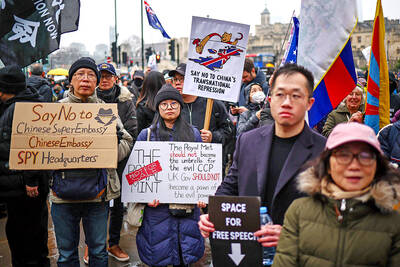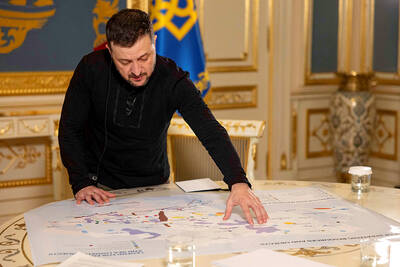A young man wearing a baseball cap emblazoned with “Dior,” women clutching babies wrapped in blankets, children bundled in winter coats, all gingerly stepped from rickety boats into the sturdy craft of the Tunisian Maritime National Guard, and away from their dreams of life in Europe.
Cold, wet and heartbroken, they are among hundreds caught daily in overnight sweeps for migrant boats on the Mediterranean Sea.
“Sit down, sit down,” an officer shouted as a woman sobbed.

Photo: AP
On an overnight expedition with the National Guard last week, reporters witnessed migrants pleading to continue their journeys to Italy in unseaworthy vessels, some taking on water. Over a period of 14 hours, 372 people were plucked from the fragile boats.
Migrants, most of them from sub-Saharan Africa, are embarking on the perilous journey in unprecedented numbers. In the first three months of this year, 13,000 migrants were forced from their boats off the eastern Tunisian port city of Sfax, the main launching point. From 2021 to last year, the number of migrants heading to Europe, mostly to Italy and Malta, nearly doubled.
In a single day in March, a record 2,900 migrants were stopped in the Sfax region, which also includes the coastal city of Mahdia and the Kerkennah Islands, off the Sfax coast, said Tunisian Maritime National Guard official Sabeur Younes said.
Migration to Europe has been on an upward climb, peaking last year to 189,620, International Organization for Migration data showed.
That is the most since 2016, when close to 400,000 left their homelands, and one year after more than 1 million people, mostly Syrians fleeing war, sought refuge in 2015.
For many sub-Saharan Africans — who do not need a visa to travel to Tunisia — the North African country serves as a stepping stone to Europe, while others come from Libya, which shares a border with Tunisia.
Each night, National Guard vessels comb the waters. Pulling up the dead is the grimmest part of the job.
The Tunisian Forum for Economic and Social Rights said that 580 migrants died or disappeared at sea last year.
Sfax officials this week were rushing to bury about 90 bodies washed up on beaches in the region, the TAP news agency reported on Tuesday.
The morgue at the main hospital is full, making burials critical. No deaths or disappearances were reported the night reporters were present.
The groups of people plucked from the water during numerous sorties by small crafts are collected on a waiting National Guard ship and returned to Sfax.
Considered victims, not lawbreakers, those stopped are set free at the port, and many try again.
Italy is trying to stem the flow from Tunisia, and stabilize the North African country in the midst of its deepest economic crisis in a generation, with growing social and political tensions. This month Rome declared a state of emergency to help cope with the influx, then sweetened pressure on Tunisia, vowing a host of investments.
As of Monday, 36,610 migrants — including 2,882 Tunisians — had reached Italy since the start of the year. That is about four times the number who arrived in each of the two previous years, the Italian Ministry of the Interior said.
Many head to Lampedusa, an island south of Sicily, about 180km from Sfax, a voyage that requires large measures of desperation and bravado.
Younes said that a critical link with Italy is missing.
“We need direct contact with the Italians for boats that risk sinking,” but have exited Tunisia’s zone of rescue, Younes said, rejecting suggestions that Tunisia is not doing enough to stop the influx of migrants.
For the migrants, Tunisia is already doing too much — dashing their dreams.
“We want to leave Tunisia. Let us die at sea. It’s our choice,” one person said after being forced off a boat. “It’s our destiny.”

Thousands gathered across New Zealand yesterday to celebrate the signing of the country’s founding document and some called for an end to government policies that critics say erode the rights promised to the indigenous Maori population. As the sun rose on the dawn service at Waitangi where the Treaty of Waitangi was first signed between the British Crown and Maori chiefs in 1840, some community leaders called on the government to honor promises made 185 years ago. The call was repeated at peaceful rallies that drew several hundred people later in the day. “This government is attacking tangata whenua [indigenous people] on all

RIGHTS FEARS: A protester said Beijing would use the embassy to catch and send Hong Kongers to China, while a lawmaker said Chinese agents had threatened Britons Hundreds of demonstrators on Saturday protested at a site earmarked for Beijing’s controversial new embassy in London over human rights and security concerns. The new embassy — if approved by the British government — would be the “biggest Chinese embassy in Europe,” one lawmaker said earlier. Protester Iona Boswell, a 40-year-old social worker, said there was “no need for a mega embassy here” and that she believed it would be used to facilitate the “harassment of dissidents.” China has for several years been trying to relocate its embassy, currently in the British capital’s upmarket Marylebone district, to the sprawling historic site in the

‘IMPOSSIBLE’: The authors of the study, which was published in an environment journal, said that the findings appeared grim, but that honesty is necessary for change Holding long-term global warming to 2°C — the fallback target of the Paris climate accord — is now “impossible,” according to a new analysis published by leading scientists. Led by renowned climatologist James Hansen, the paper appears in the journal Environment: Science and Policy for Sustainable Development and concludes that Earth’s climate is more sensitive to rising greenhouse gas emissions than previously thought. Compounding the crisis, Hansen and colleagues argued, is a recent decline in sunlight-blocking aerosol pollution from the shipping industry, which had been mitigating some of the warming. An ambitious climate change scenario outlined by the UN’s climate

BACK TO BATTLE: North Korean soldiers have returned to the front lines in Russia’s Kursk region after earlier reports that Moscow had withdrawn them following heavy losses Ukrainian President Volodymyr Zelenskiy on Friday pored over a once-classified map of vast deposits of rare earths and other critical minerals as part of a push to appeal to US President Donald Trump’s penchant for a deal. The US president, whose administration is pressing for a rapid end to Ukraine’s war with Russia, on Monday said he wanted Ukraine to supply the US with rare earths and other minerals in return for financially supporting its war effort. “If we are talking about a deal, then let’s do a deal, we are only for it,” Zelenskiy said, emphasizing Ukraine’s need for security guarantees